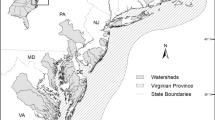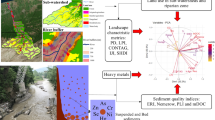Abstract
Prior studies exploring the quantitative relationship between landscape structure metrics and the ecological condition of receiving waters have used a variety of sampling units (e.g., a watershed, or a buffer around a sampling station) at a variety of spatial scales to generate landscape metrics resulting in little consensus on which scales best describe land-water relationships. Additionally, the majority of these studies have focused on freshwater systems and it is not clear whether results are transferable to estuarine and marine systems. We examined how sampling unit scale controls the relationship between landscape structure and sediment metal concentrations in small estuarine systems in the Mid-Atlantic region of the United States. We varied the spatial extent of the contributing watersheds used to calculate landscape structure and assessed linear relationships between estuarine sediment metal concentrations and the total area of developed and agricultural lands at each scale. Area of developed lands was consistently related to sediment metals while total agricultural land was not. Developed land had strongest associations with lead and copper; weakest with arsenic and chromium; and moderate associations with cadmium, mercury, and zinc. Local (i.e., less than 15−20 km from a sampling station) land uses have a greater impact than more distant land uses on the amount of toxic metals reaching estuarine sediments.



Similar content being viewed by others
References
Anderson JR, Hardy EE, Roach JT et al (1976) USGS professional paper 964. U.S. Geological Survey, Washington, DC
Bailey D, Billeter R, Aviron S et al (2006) The influence of thematic resolution on metric selection for biodiveristy monitoring in agricultural landscapes. Landsc Ecol 22:461–473
Baldwin DJB, Weaver K, Schnekenburger F et al (2004) Sensitivity of landscape pattern indices to input data characteristics on real landscapes: implications for their use in natural disturbance emulation. Landsc Ecol 19:255–271
Blake AC, Chadwick DB, Zirino A et al (2004) Spatial and temporal variations in copper speciation in San Diego Bay. Estuaries 27:437–447
Carpenter SR, Caraco NF, Correll DL et al (1998) Nonpoint pollution of surface waters with phosphorus and nitrogen. Ecol Appl 8:559–568
Cohen J, Cohen P (1983) Applied multiple regression/correlation analysis for the behavioral sciences. Lawrence Erlbaum Associates, Hillsdale, New Jersey
Comeleo RL, Paul JF, August PV et al (1996) Relationships between watershed stressors and sediment contamination in Chesapeake Bay estuaries. Landsc Ecol 11:307–319
daSilva S (2004) A multiple scale approach to assessing the biological integrity of Rhode Island streams. Thesis, University of Rhode Island
Dauer DM, Ranasinghe JA, Weisber SB (2000) Relationships between benthic community condition, water quality, sediment quality, nutrient loads, and land use patterns in Chesapeake Bay. Estuaries 23:80–96
Dungan JL, Perry JN, Dale MRT et al (2002) A balanced view of scale in spatial statistical analysis. Ecography 25:626–640
Duinker JC, Nolting RF (1978) Mixing, removal, and mobilization of trace metals in the Rhine Estaury. Netherlands J Sea Res 12:205
ESRI (Environmental Systems Research Institute) (2005) ArcGIS: Release 9.1 [software]: Environmental Systems Research Institute, Redlands, California
Gergel SE (2005) Spatial and non-spatial factors: when do they affect landscape indicators of watershed loading? Landsc Ecol 20:177–189
Gergel SE, Turner MG, Kratz TK (1999) Scale-dependent landscape effects on north temperate lakes and rivers. Ecol Appl 9:1377–1390
Gustafson EJ (1998) Quantifying landscape spatial pattern: what is the state of the art? Ecosystems 1:143–156
Hale SS, Paul JF, Heltshe JF (2004) Watershed landscape indicators of estuarine benthic condition. Estuaries 27:283–295
Hall O, Hay GJ, Bouchard A et al (2004) Detecting dominant landscape objects through multiple scales: An integration of object-specific methods and watershed segmentation. Landsc Ecol 19:59–76
He Z, Zhao W, Chang X (2007) The modifiable areal unit problem of spatial heterogeneity of plant community in the transitional zone between oasis and desert using semivariance analysis. Landsc Ecol 22:95–104
Hollister JW (2004) Predicting condition of small estuarine systems along the United States Atlantic coast. Dissertation, University of Rhode Island
Hollister JW, Gonzalez LM, Paul JF et al (2004) Assessing the accuracy of the National Land Cover Dataset at multiple spatial extents. Photogramm Eng Rem S70:405–414
Hunsaker CT, Levine DA (1995) Hierarchical approaches to the study of water quality in rivers. BioScience 45:193–203
Jelinski DE, Wu J (1996) The modifiable areal unit problem and implications for landscape ecology. Landsc Ecol 11:129–140
Jones KB, Riitters KH, Wickham JD et al (1997) An ecological assessment of the United States mid-Atlantic region: a landscape atlas. EPA/600/R-97/130. Office of Research and Development, U. S. Environmental Protection Agency, Washington, DC
Kadlec RH, Kadlec JA (1979) Wetlands and water quality. In: Gresson PE, Clark JR, Clark JE (eds) Wetland functions and values: the state of our understanding. American Water Resources Association, Proceedings of the National Symposium on Wetlands, Florida, pp 436–456
Kearns FR, Kelly NM, Carter JL et al (2005) A method for the use of landscape metrics in freshwater research and management. Landsc Ecol 20:113–125
Kennish MJ (1986) Ecology of estuaries, vol I: physical and chemical aspects. CRC Press, Boca Raton, Florida
King RS, Baker ME, Whigham DF et al (2005) Spatial considerations for linking watershed land cover to eological indicators in streams. Ecol Appl 15:137–153
Levin SA (1992) The problem of pattern and scale in ecology. Ecology 73:1943–1983
Long ER, MacDonald DD, Smith SL et al (1995) Incidence of adverse biological effect within ranges of chemical concentration in marine and estuarine sediment. Environ Manage 19:81–97
McGarigal K, Marks BJ (1995) FRAGSTATS: spatial pattern analysis program for quantifying landscape structure . General Technical Report PNW-GTR-351. USDA Forest Service, Pacific Northwest Research Station, Portland OR
Monbet P (2004) Seasonal cycle and mass balance of cadmium in an estuary with an agricultural catchment: The Morlaix River Estuary (Brittany, France). Estuaries 27:448–459
Morley SA, Karr JR (2002) Assessing and restoring the health of urban streams. Conserv Biol 16:1498–1509
Novotny V, Olem H (1994) Water quality: prevention, identification, and management of diffuse pollution. Van Nostrand Reinhold, New York
Nriagu JO, Pacyna JM (1988) Quantitative assessment of worldwide contamination of air, water, and soils by trace metals. Nature 333:134–139
O’Neill RV, Hunsaker CT, Timmins SP et al (1996) Scale problems in reporting landscape pattern at the regional scale. Landsc Ecol 11:169–180
Omernik JM, Abernathy AR, Male LM (1981) Stream nutrient levels and proximity of agricultural and forest land to streams: some relationships. J Soil Water Conserv 36
Openshaw S (1984) The modifiable areal unit problem. Geo Books, Norwich
Overton WS, White D, Stevens DL (1991) Design report of the Environmental Monitoring and Assessment Program . EPA/600/3−91/053. US Environmental Protection Agency, Environmental Research Laboratory, Corvallis, OR
Pacheco PA (1993) Point source methods document for the Virginian Province. National Oceanic and Atmospheric Administration, Silver Spring, MD
Paul JF, Scott KJ, Holland AF et al (1992) The estuarine component of the US E. P. A. ‘s Environmental Monitoring and Assessment Program. Chem Ecol 7:93–116
Paul JF, Gentile KJ, Scott KJ et al (1999) EMAP-Virginian Province four year assessment (1990–1993). EPA/620/R-99/004. US Environmental Protection Agency, Office of Research and Development, Washington, DC
Paul JF, Comeleo RL, Copeland JL (2002) Quantitative relationships between landscape metrics and sediment contamination for small estuarine systems in the mid-Atlantic and southern New England regions of the United States. J Environ Qual 31:836–845
SAB (Science Advisory Board) (1988) Future risk: research strategies for the 1990s. The report of the Research Strategies Committee. Science Advisory Board, Washington, DC
Satarug S, Baker JR, Urbenjapol S et al (2003) A global perspective on cadmium pollution and toxicity in non-occupationally exposed population. Toxic Lett 137:65–83
Schroeder HA (1974) The poisons around us: toxic metals in food, air, and water. Indiana University Press, Bloomington, IN
Stehman SV, Wickham JD, Yang L et al (2003) Thematic accuracy of the 1992 National Land-Cover Data (NLCD) for the eastern United States: statistical methodology and regional results. Remote Sens Environ 86:500–516
Turner MG, O’Neill RV, Gardner RG et al (1989) Effects of changing spatial scale on the analysis of landscape pattern. Landsc Ecol 3:153–162
Turner MG, Gardner RH, O’Neill RV (2001) Landscape ecology in theory and practice. Springer-Verlag, New York
USEPA (United States Environmental Protection Agency) (1990) Urban targeting and BMP selection. An information and guidance manual for state NPS program staff. EPA 660/3−74-02C. USEPA Office of Water, Washington, DC
USEPA (United States Environmental Protection Agency) (1995) National water quality inventory: 1994 report to Congress. 841-R-95-005. USEPA, Washington, DC
USGS (United States Geological Survey) (2003) Accuracy assessment of 1992 National Land Cover Data. Available from http://landcover.usgs.gov/accuracy (accessed Feb 2007)
Urban DL, O’Neill RV, Shugart HH (1987) Landscape ecology. Bioscience 37:119–127
Vogelmann JE, Sohl T, Howard SM (1998a) Regional characterization of land cover using multiple sources of data. Photogramm Eng Rem S64:45–57
Vogelmann JE, Sohl T, Howard SM et al (1998b) Regional land cover characterization using Landsat thematic mapper data and Ancillary Data. Environ Monit Assess 51:415–428
Vogelmann JE, Howard SM, Yang L et al (2001) Completion of the 1990’s National Land Cover Data Set for the conterminous United States from Landsat thematic mapper data and ancillary data sources. Photogramm Eng Rem S67:650–662
Wang L, Lyons J, Kanehl P et al (1997) Influences of watershed land use on habitat quality and biotic integrity in Wisconsin streams. Fisheries 22:6–12
Weller DE, Jordan TE, Correll DL (1998) Heuristic models for material discharge from landscapes with riparian buffers. Ecol Appl 8:1156–1169
Weller DE, Jordan TE, Correll DL et al (2003) Effects of land-use change on Nutrient Discharges from the Patuxent River Watershed . Estuaries 26:244–266
Wickham JD, Riitters KH (1995) Sensitivity of landscape metrics to pixel size. Int J Remote Sens 16:3585–3594
Wiens JA (1989) Spatial scaling in ecology. Funct Ecol 3:385–397
Wu J (2004) Effects of changing scale on landscape pattern analysis: Scaling relations. Landsc Ecol 19:125–138
Wu J, Li H (2006) Concepts of scale and scaling. In: Wu J, Jones KB, Li H et al (eds) Scaling and uncertainty analysis in ecology: Methods and applications. Springer, Dordrecht
Yang L, Stehman SV, Smith JH et al (2001) Thematic accuracy of MRLC land cover for the eastern United States. Remote Sens Environ 76:418–422
Zar JH (1999) Biostatistical analysis. Prentice Hall, New Jersey
Acknowledgements
We thank all reviewers of this manuscript for their time and effort whose thoughtful comments greatly improved our final product. We also thank the University of Rhode Island, the US Environmental Protection Agency, Rhode Island Natural History Survey, and the Rhode Island Chapter of Surfrider who provided funds and/or facilities for the successful completion of this project. The Department of Science and CAPT Mike Alfultis at the U.S. Coast Guard Academy deserve special mention as they provided time and support for JWH to put the finishing touches on this manuscript. JWH was initially partially supported through USEPA Cooperative Agreement CT825802, Brian D. Melzian, Project Officer. The research described in this paper has been funded in part by the US Environmental Protection Agency. This paper has not been subjected to Agency review. Therefore, it does not necessary reflect the views of the Agency. Mention of trade names or commercial products does not constitute endorsement or recommendation for use. This is contribution number AED-06−074 of the Atlantic Ecology Division, National Health and Environmental Effects Research Laboratory.
Author information
Authors and Affiliations
Corresponding author
Rights and permissions
About this article
Cite this article
Hollister, J.W., August, P.V. & Paul, J.F. Effects of spatial extent on landscape structure and sediment metal concentration relationships in small estuarine systems of the United States’ Mid-Atlantic Coast. Landscape Ecol 23 (Suppl 1), 91–106 (2008). https://doi.org/10.1007/s10980-007-9143-1
Received:
Accepted:
Published:
Issue Date:
DOI: https://doi.org/10.1007/s10980-007-9143-1




